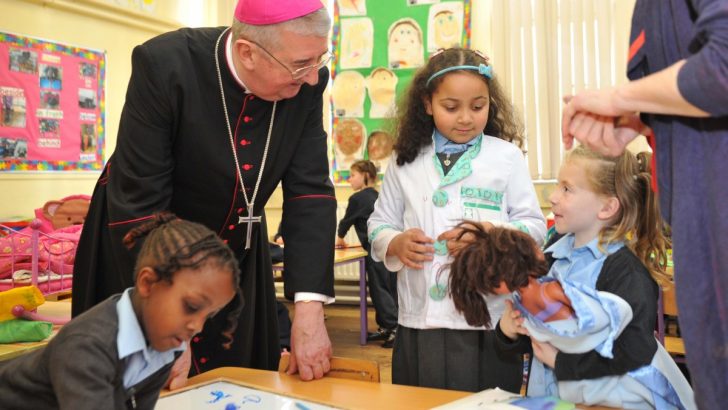“Bruton set to pledge end of school ‘baptism barrier’”, read the headline in one newspaper on Monday. It was typical of the headlines in a number of news outlets. Reading those headlines you could be forgiven for thinking that Education Minister, Richard Bruton, has decided to altogether abolish the right of Catholic schools to admit Catholic children first, and other children after that. But it’s not so, even if it is one out of four options on the table.
On Monday, Richard Bruton gave an address at a conference held by Equate, an organisation dedicated to removing the rights of faith schools to serve children of their own faith community first, a policy Equate says is unjustified discrimination.
Defenders say faith schools must be permitted to carry out their founding purpose, and the founding purpose of a faith school is to serve children and parents who share the faith of the school, just as Irish language schools serve those dedicated to the Irish language.
The first of the four options Bruton outlined was a ‘catchment area’ approach. This would allow a Catholic school to admit Catholics from a school’s catchment area first, but then would have to admit non-Catholic children from within the catchment area in preference to Catholic children from outside the catchment area.
The second option, a “nearest school rule” is similar to the first option.
The third option is a quota system. This would allow schools to set aside a certain percentage of places for children of the faith of the school.
Support
A ban on religious schools using religion as a factor in admissions is the final option, but parents would have to show some level of support for the ethos of the school.
None of the options is for the status quo, and the Minister has indicated a public consultation purpose lasting about 12 weeks. He wants to hear from minority faith schools, for instance. These would potentially be hit hardest by a change in admissions policy because even now, a minority of children in many Church of Ireland schools are actually from the Church of Ireland. It would almost completely defeat the purpose of a Church of Ireland school if it had to turn away Church of Ireland children out of preference to children of others faiths or none.
What’s interesting is that the Minister has launched this process at all. Where is the demand for it? Certainly, the Labour party wants it. Various newspapers want it. Campaign groups like Equate want it. (Labour’s Ruairi Quinn is on the board of Equate). But do the public really want it?
Equate produces polls showing they do, but when parents are concretely asked whether they want the faith school in their area to become another kind of school, there is little support.
A Department of Education survey conducted when Ruairi Quinn was Education Minister in 43 areas around the country and taking in several hundred schools, found little support for handing the local faith schools over to other patron bodies such as Educate Together.
In addition, outside of a handful of areas, mostly on the southside of Dublin, TDs rarely hear complaints from constituents that they cannot get their children into their local school because of the ‘baptism barrier’ that is, because their children are not baptised into the faith of the school.
The reason they rarely hear complaints is because the vast majority of schools around the country have enough school places to meet demand from all parents. A survey conducted by this newspaper found that only 3% of schools don’t have enough places, and again these are mainly in Dublin.
Dublin archdiocese itself surveyed its 450 primary schools to find out how many children had to be turned down a place because of over-enrolment. Almost three-quarters of the schools replied (315), and only 12 children were refused a place last September, and eight of these were turned down by the one school. This does not indicate so big a problem.
So why is the Education Minister devoting such energy to it? Ministers ought to devote their energies to the most pressing problems. Perhaps it is because this Government, like previous Governments, often dances to the tune of pressure groups and the media, more than to public pressure.
Turning up the heat on faith schools is also a way of turning down the heat on the Government itself for its failure to provide enough school places in certain areas.
The Government could say it is doing this simply as a matter of principle, so perhaps we shouldn’t be too cynical.
However, it is very hard not to see this latest move as simply the latest in a series of attacks on the rights of faith schools. It is not only their admissions policy that is under attack.
Their employment rights have already been eroded, and there are continual attacks on their ethos and their right to handle religious education in their own way. Hence the pressure to teach ‘Education about Religion, Belief and Ethics’.
As it happens the Catholic Church would be open to the first two of the options set out by Minister Bruton. Archbishop Eamon Martin has indicated before that he would favour something very like option one and probably option two as well, which would allow Catholic schools to admit local children from the Catholic faith first, and then non-Catholic children from the local area in preference to Catholic children from outside the area.
Contrast
But the contrast between the constant drumbeat of negativity emanating from Government circles about faith schools and the positivity from the British Government about them is stark.
British Prime Minister, Theresa May, has recently praised faith schools and says she intends building more Catholic schools.
The Government should bring itself to praise faith schools every now and again or we may be forced to conclude it doesn’t like them very much at all.


 David Quinn
David Quinn Archbishop of Dublin and Primate of Ireland, Diarmuid Martin, visiting Our Lady of the Wayside National School in Bluebell, Dublin. Photo: Clodagh Kilcoyne
Archbishop of Dublin and Primate of Ireland, Diarmuid Martin, visiting Our Lady of the Wayside National School in Bluebell, Dublin. Photo: Clodagh Kilcoyne